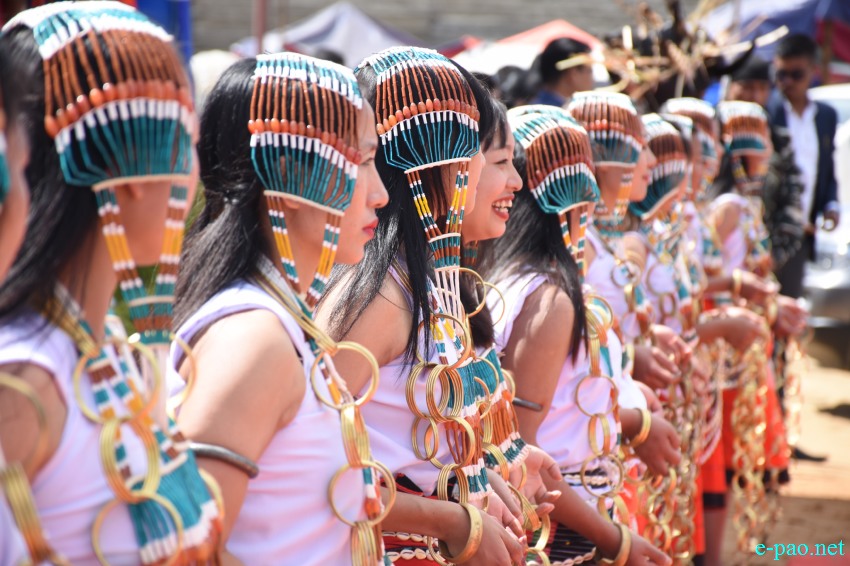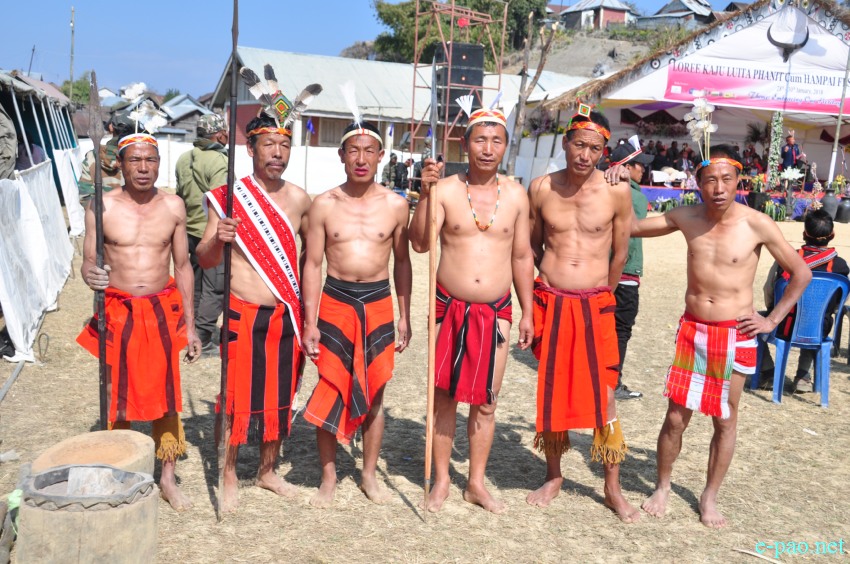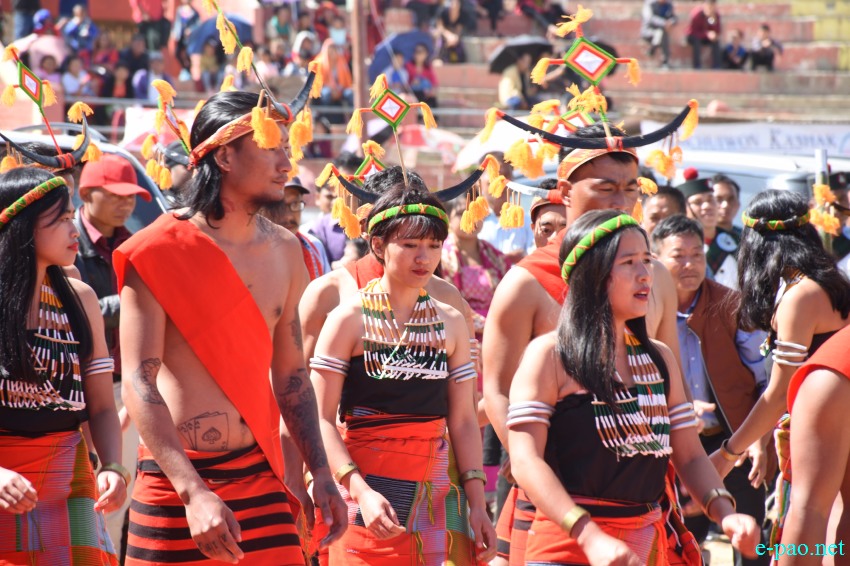Legendary textiles heritage of Tangkhul Naga tribe of Manipur
- Tribal heritage -
Joymati Thoudam / Dr Ritu Mathur *

3rd Shirui Lily Festival at TNL Ground, Ukhrul in October 2019 :: Pix - Lamdamba Oinam
The heritage of tribal arts and crafts is not a free flowing expression of an individual creativity but an intellectually processed expression accepted by collective beliefs. Tangkhul tribe is one of the largest tribes of Manipur and they have been known for distinct traditions and culture of their own.
Tangkhul tribe are living in the Indo-Burma border area occupying the Ukhrul district of Manipur and Somra Tangkhul hills in Upper Burma (Myanmar). It is believed that they came to Manipur from China through Myanmar. According to a Greek astronomer and geographer, the Tangkhuls were believed to be settled in Samshok (Thuangdut) in Myanmar and they began to disperse from Samshok in different directions.
According to the elders of the community, the word 'Tangkhul' was derived from the Meitei dialect (largest ethnic group of Manipur). Tangkhul is a combination of the words "Tada" and "Khul". Tada meaning elder brother and Khul means village. Therefore, Tangkhul means the village of elder brother.
Tangkhul tribe has legendary textiles heritage in terms of traditional costumes, colours, specific design and motifs with significance and symbolism. The traditional textiles of the tribe are not only derived from the environmental physiology, but also marked socio-cultural meanings that reveal the societal norms. They reflect age, sex, social status and sacred or profane activities which appear in various contexts.
Both unmarried and married women were engaged in art of weaving. They made the requirement of their family for everyday use and for ceremonial wear. Traditionally, it was considered to be one of the basic skills to be learnt by a woman before getting married.
Cotton was the most preferred yarn to weave their fabrics. In earlier times, most of the Tangkhul villages not only wove cotton cloth but also cultivated cotton and spun it into yarn.
According to the elder people of the community, in earlier times, barter system of cotton with other goods was also practiced between the tribes people and Meiteis. The tribe people used to trade cotton with the Meiteis weavers and in return they got goods which were not easily available in hills.
Red, black and white colours were dominantly used on their textiles as a base. Colours such as green, blue, yellow/orange were used for designing motifs. Earlier, the tribe people followed dyeing process using naturally available materials such as fruits, barks and roots of different trees, clay and mud. They made the colour combinations ideally suited for the hill environment. They used to dye hand spun cotton yarn for their weaving as well as cane, bamboo stalk or animal hair for their accessories.
Base fabric was woven in plain weave and swivel extra weft technique was used for designing motifs. Woven at the loin loom, the breadth of the cloth is generally narrow. They had to stitch together two or more pieces of cloth by hand to get wider cloth.
Traditionally, the weavers got inspiration for designs and motifs from their natural surroundings. They wove designs very intricately and mostly used motifs such as insects, animals, plants, and geometrical shapes on the textiles.
The traditional textiles of Tangkhul can be broadly classified as unisex textiles, male (upper and lower) garments and female (upper and lower) garments. All the costumes comprised of draped garments. Little or no stitching was done. Draping required considerable expertise to make the costume look elegant as well as functional. The chief garments were shawls and sarongs-Kachon is a shawl and Kashan is a female sarong in Tangkhul dialects.
They draped their shawls around the upper body and these shawls could be used by them in different styles which clearly laid down societal norms and regulations. Sarong was used extensively as lower garment by female folk.
Sapa shawl, Raivat Kachon and Chonkhom are the important unisex textiles of Tangkhul. Sapa shawl can be worn by unmarried men and women. It is also used as a blanket during winter. Raivat Kachon, is woven in black base and decorated with hand embroidered designs. The shawl can be worn by the chief and important persons in the village such as warriors, head hunters, heroes and men who performed feats of merit. It is also used as a bridal shawl.
The Meitei community also used this shawl and referred to it by name of Shaphee-Lanphee. It was told that earlier, the Meitei kings used to give the shawl to tribal chiefs as a token of love and respect on special occasions and festivals.
One of the famous shawls amongst the Tangkhul youths is Chonkhom Kachon. It is woven in red base with broad black colour stripes. The shawl can be worn by first youngest or second youngest male member of the family. It was also used as an over garment by unmarried womenfolk.

Loree Kaju Luita Phanit / Hampai Festival at Nungpi Khullen, Ukhrul in January, 2018 :: Pix - Lamdamba Oinam
Male upper garments include Haora Kachon, Luirim Kachon, Tara Kadipui and Thangkang Kachon. Hoara Kachon is one of the inseparable shawls of male folk. One of the unique features of Haora shawl is Ramik/Amik design which was woven along the white broad lengthwise stripes in the shawl. Ramik/Amik is a dotted line in black colour. It was reported that the design symbolised the eye of loin loom.
There are two types of Haora shawls based on size -one which was made of five panels of woven cloth and could be worn by all men. Secondly, the shawl could be made by joining seven panels of woven cloth and it could be worn only by head or eldest son of the family.
Another famous shawl worn by men folk is Luirim Kachon. The shawl could be worn by men who had performed feats of merit, Awunga, chiefs of Hangva (clans) or eldest son of a lineage or who belonged to the royal family. The shawl is also one of the important cloths of Meities.
The Meiteis called it as "Leirum" and they used it for binding blanket and bed covers which were to be carried by the bride. A plain off white cotton shawl called as Tara Kadipui, is especially reserved for those who had performed feats of merit.
Thangkang Kachon, shawl is reserved for senior aged men folk of the village community. Rich or royal family male elders and Ammei, a senior member of a family or clan also wore the shawl.
According to the information given by the elder people of the Tangkhul tribe, in earlier days, males usually wore shawl only in cold weather or due to changing temperature during evening. The only lower garment for males in addition to shawls is Raokha /Malloa. The loin dress is worn during festivals, performing folk dances as well as daily wear.
In earlier days, women also did not use blouse or shirt. They left the upper part of the body uncovered while they worked in fields as it made them clumsy and was considered inconvenient. However, Muka, a plain black piece of woven cloth was worn as a bustier by women.
The bustier is worn during festivals, special occasions, while performing traditional dances as well as daily wear. The only other upper garment was a shawl referred to as Phingu, woven in black base with a pink colour border using cotton yarn. It is worn by married women during mourning ceremony.
Female lower garments consist of Kongra Kashan, Zingtai-Manshing la Kashan, Seichang Kashan and Phangyai Kashan. Mostly all lower garments were different types of sarongs. Women draped them in different style based on socially acceptable norms.
Kongra Kashan is woven in deep red base and white broad stripes all over. As per information received from the senior weavers, the white broad stripes signified flowing water from waterfalls. This lower garment could be worn by all females as every day wear or on occasions. Zingtai Manshing la Kashan is woven in red colour base and black stripes in middle with Cicada and Phorie motifs.
Phorei motifs symbolised the skin of Python God and Cicada motif was inspired from butterfly. The motifs are traditionally woven in two colours i.e. green and white. It was believed that this cloth was named in memory of Manshing-la, considered to be the first weaver among the Tangkhul tribe from Zingtai village.
On the other hand, Seichang Kashan can be worn only by the elder daughter of village chief or chief of clan. This garment was also used as a bridal dress. Phangyai Kashan is special sarong made by joining three panels of woven cloth. The middle panel of the sarong was woven in more intricate design than the other two side panels. In earlier days, the cloth could only worn by wife of village chief and women belonging to wealthy families.
Tangkhuls are very fond of adorning themselves with jewellery and ornaments as a part of their costumes. Ornaments of Tangkhul can also be broadly classified as unisex, male and female ornaments.

3rd Shirui Lily Festival at TNL Ground, Ukhrul in October 2019 :: Pix - Lamdamba Oinam
Unisex ornaments are Kongshang (necklace made of ivory and sea shell) and Chaokui (brass bangle). As per elder people of the tribe, Kongshang is one of the most important ornaments of the community which bestows a feeling of identity and therefore it is popular within the community till date.
Chaokui (was worn in singles by males and female wore it in pairs. Male ornaments include Narun (cylindrical wooden ear wear), Quilop (warrior cap made from animal fur and cane), Pasi (head wear made from cane, dried stem of an orchid and bamboo) and cane leg wear.
Female ornaments consists of Huison ((brass ring chain worn to adorn head and hanging down till leg), Har (Circular aluminium armlet), Nahui (ear piece made of circular crystal), Khom mashin (waist wear made from cowries and black beads), Zeithing (iron stick used as a part of bridal ornament).
In earlier days, Tangkhul tribe had definitive norms to wear their traditional textiles and costumes based on sex, age, social and marital status. Today, the use of traditional textiles and costumes of the tribe has declined not only in urban areas over the last few decades but also in rural areas.
The traditional textiles and costumes of the tribe have been changed in many aspects such as design, motifs placement, yarn, colour and uses and also have been slowly replaced by contemporised textiles and costumes. Very few tribe people have the knowledge of indigenous practices such as spinning and dyeing process. These may be due to substantial changes in the life style of the tribe.
However, the tribe people still engage in loin loom weaving in their houses. Today, many traditional textiles are not used anymore except for the few which are worn on community occasions, calendric festivals and dances.
* Joymati Thoudam / Dr Ritu Mathur wrote this article for The Sangai Express
Joymati Thoudam, Research Scholar and Dr. Ritu Mathur, Associate Professor Dept. of Fabric & Apparel Science (Home Science) Lady Irwin College, University of Delhi
They can be reached at joymati(DOT)thoudam(AT)gmail(DOT)com, ritumathur16(AT)gmail(DOT)com
This article was posted on May 28, 2021.
* Comments posted by users in this discussion thread and other parts of this site are opinions of the individuals posting them (whose user ID is displayed alongside) and not the views of e-pao.net. We strongly recommend that users exercise responsibility, sensitivity and caution over language while writing your opinions which will be seen and read by other users. Please read a complete Guideline on using comments on this website.








